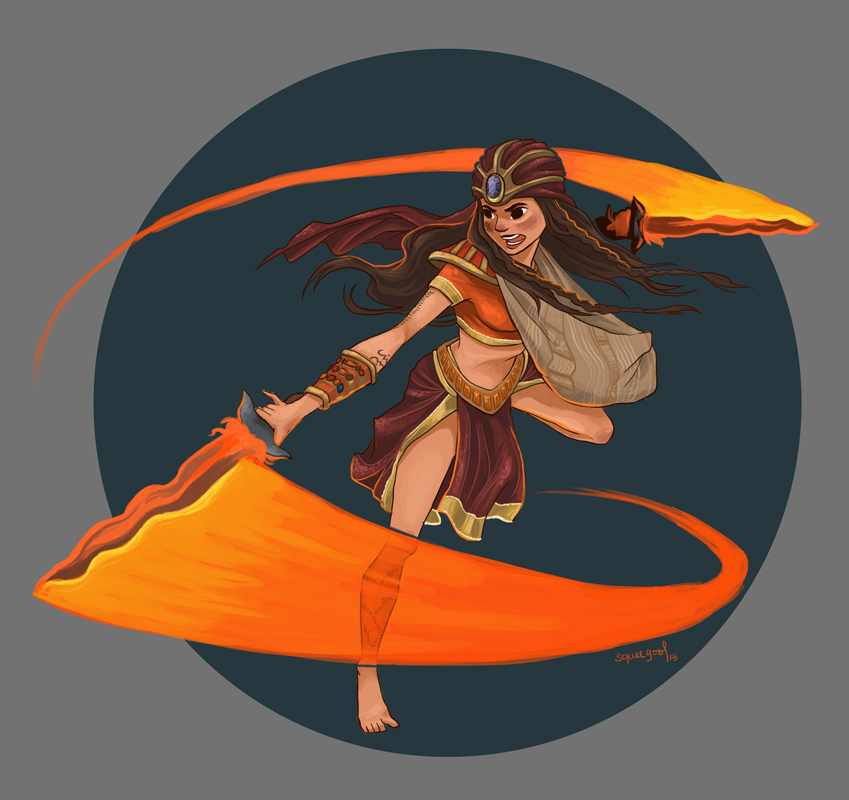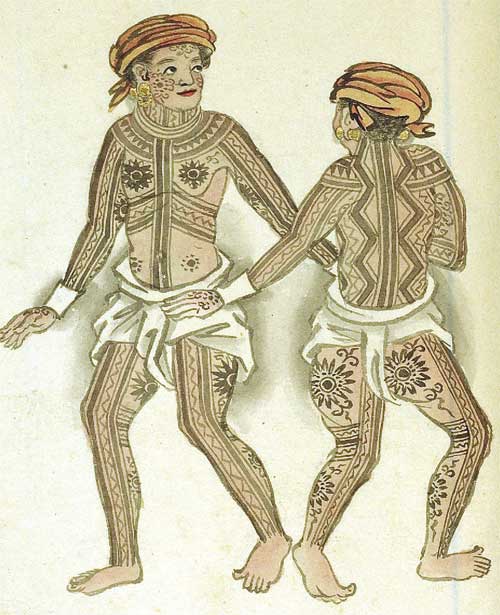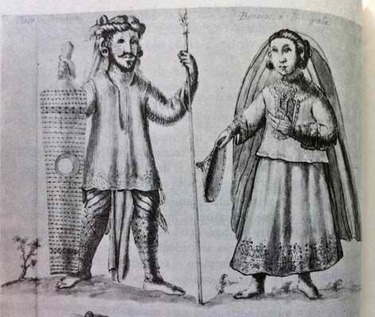The “trinity” of Visayan War gods invoked before or during battle were Yna Guinid (the goddess of war and poisons), Barangaw (the god of rainbow and symbol of hope), and Makanduk (god of war and plunder) – patron god of the mangatang or sea bandits/pirates.
The Timawa were the privileged intermediate class of ancient Visayan society, in between the uripon (commoners, serfs, and slaves) and the tumao (royal nobility). They were originally descendants or illegitimate children of the datu by commoner wives or uripon concubines, or the illegitimate children of the binokot princesses.
Like the Tagalog Maharlika class, the Timawa were primarily a feudal warrior class, required to provide military service to the datu in hunts, land wars (Mangubat or Managayau), and sea raids (Mangahat or Magahat). They also paid tribute or taxes to the datu known as buhis or handug and were required to provide agricultural labor as needed. They enjoyed certain freedoms, like the right to own their own land and uripon, the right to lend and borrow money, and the right to enter into business partnerships
This warrior class had deities which they called upon – Nagunid or Ynaguinid, Macanduk or Malandok and Barangaw/Balangaw. Babaylans would intercede on behalf of the warriors, and commune with the deities. There are two kinds of babaylan: the living babaylan and heavenly babaylan. The living babaylans are babaylans who are still living in the physical world, who serve people and help to control day to day negative happenings on earth. The heavenly babaylans are thebabaylans who directly receive heaven’s messages from God. The heavenly babaylans guide the living babaylans, who also receive messages from heaven but serve people directly on earth.
A babaylan is “a specialist in the fields of culture, religion, medicine and all kinds of theoretical knowledge about the phenomenon of nature.”
— Marianita “Girlie” C. Villariba, sociologist and anthropologist

Who were the Visayan war gods?
It is a historical fact that the worship of these deities was an important part of the formidable Visayan warrior culture. In Relacion de las Yslas Filipinas (June 1582), Miguel de Loarca states, “When they go to war or on a plundering expedition, they offer prayers to Varangao (Barangaw), who is the rainbow, and to their gods, Ynaguinid and Macanduc. For the redemption of souls detained in the inferno above mentioned, they invoke also their ancestors, and the dead, claiming to see them and receive answers to their questions.”
Unfortunately, this is the only historical reference we have that directly relates to them. Anything beyond this cursory mention, is speculation – not to discredit any educated speculation.

Participating in land and sea raids were an essential part of the duties of the timawa. These raids are usually regular annual expeditions undertaken by the community (compare with Viking) against enemies and enemies of their allies. Participation and conduct in raids and other battles were recorded permanently by the timawa and the tumao in the form of tattoos on their bodies, hence the Spanish name for them – pintados (literally “the painted ones”). Miguel de Loarca described the preparations and the undertaking of such raids as thus:
- “These natives have a method of casting lots with the teeth of a crocodile or of a wild boar. During the ceremony they invoke their gods and their ancestors, and inquire of them as to the result of their wars and their journeys. By knots or loops which they make with cords, they foretell what will happen to them; and they resort to these practices for everything which they have to undertake. The Indians along the coast are accustomed to set out every year on their plundering expeditions in the season of the bonanças, which come between the brisas and the vendabals. The Tinguianes set out after they have gathered their harvests; and since their custom is to be enemies to those who are such to their friends, they do not lack opportunity for fighting.”

Finally, William Henry Scott, in his study Barangay: Sixteenth-century Philippine Culture and Society, says of the Visayan war culture, “The datu’s main function is to lead in war. Warfare – “mangubat” in general, “mangayaw” by sea, and “magahat” by land – appears as endemic in all the accounts. It takes the form of raiding, trading, or a combination of both, and is terminated or interrupted by blood compacts between individuals or whole gamoros. Slaving is so common everybody knows the proper behavior patterns. A captured datu is treated with respect and his ransom underwritten by some benefactor who will realize a 100 percent profit on the investment. Men who surrender may not be killed, and the weak and effeminate are handled gently; a timawa who kills a captive already seized must reimburse his datu. A commanding datu rewards his crewmen at his own discretion, but otherwise has full rights to profit and booty. In the event of a combined fleet, the datu who provides the predeparture sacrifices to ancestral spirits and war deities receives half the total take. Visayan men-of-war are highly refined specimens of marine architecture which call for considerable capital investment to construct, outfit, and operate, and are launched over the bodies of slave victims.”
One commonality in all the historical reports is that the Visayans were a powerful force on land and sea, and that the belief and worship of these three deities played a huge part in the preparations and culture surrounding those practices.
Jordan Clark is a Canadian born descendant of Scottish immigrants living on the homelands of the Lekwungen speaking peoples. His interest in Philippine myth and folklore began in 2004. Finding it difficult to track down resources on the topic, he founded The Aswang Project in 2006. Shortly after, he embarked on a 5 year journey, along with producing partner Cheryl Anne del Rosario, to make the 2011 feature length documentary THE ASWANG PHENOMENON – an exploration of the aswang myth and its effects on Philippine society. In 2015 he directed “The Creatures of Philippine Mythology” web-series, which features 3 folkloric beings from the Philippines – the TIKBALANG, KAPRE and BAKUNAWA. Episodes are available to watch on YouTube. Jordan recently oversaw the editing for the English language release of Ferdinand Blumentritt’s DICCIONARIO MITOLÓGICO DE FILIPINAS (Dictionary of Philippine Mythology) and is working on two more releases with fellow creators scheduled for release later this year. When his nose isn’t in a book, he spends time with his amazing Filipina wife of 20 years and their smart and wonderful teenaged daughter.


